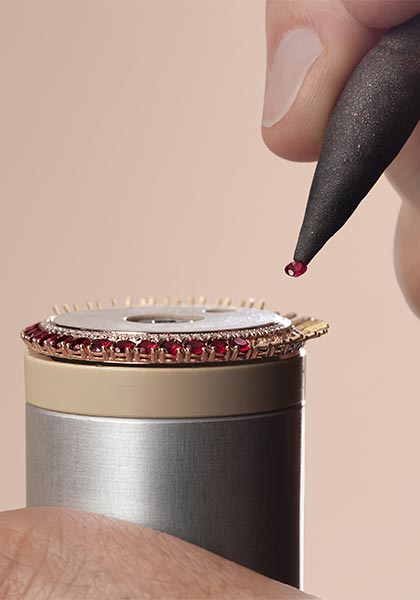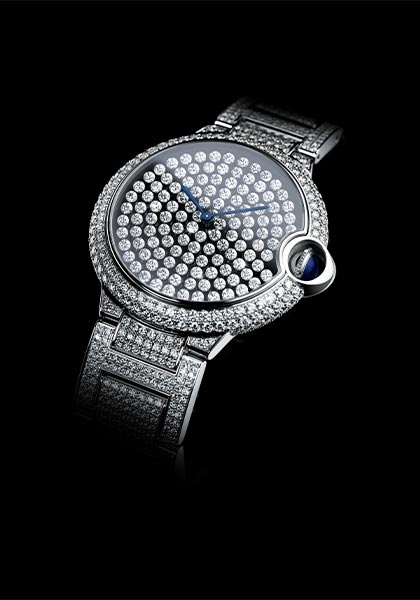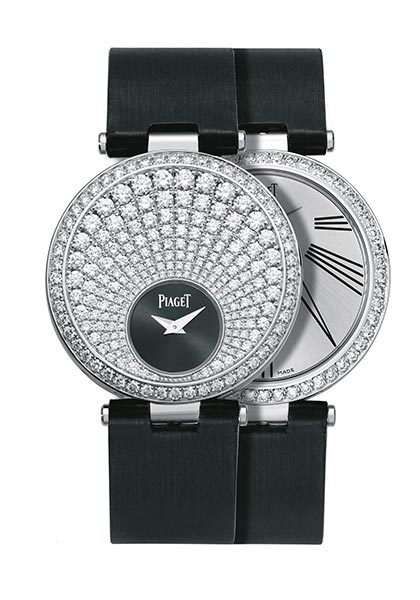However, beyond the shimmering dazzle, what is often overlooked is the depth, breadth and scope of master craftsmanship that goes into the designing and making of these sculptural works of art for the wrist. And, as of the 21st century, that art has evolved immensely – taking the idea of diamond- and gemstone-adorned timing to all-new levels.
Whereas in the early 20th century, evolutions of diamond watches crept along at a slow-to-moderate pace, the 21st century advancements are moving at a speed almost as fast as our lifestyles. This quick-stride development is due in part to a host of progressions in diamond and gemstone cutting and setting techniques – some borrowed from the jewellery industry, and others developed by watch brands. It has also been spurred by an untiring quest for advancements in styles, designs and even uses of gemstones to create unparalleled and unique stories on the wrist.
The Evolution of Settings and Cuts
Throughout the 1900s, the watch world most often utilised existing jewellery setting techniques, such as invisible, channel and pavé settings, for their watches. These designs mostly consisted of standard-shaped diamonds such as the brilliant-cut or the baguette-cut stone.
However, as the century turned, new and unique diamond settings and cuts emerged, as did developments in technology. Many of the top-notch settings found in today’s watches could not have been made possible without technology. Computer Aided Design (CAD) evolved even more quickly than gemsetting techniques, progressing to the point where brands could actually intricately and precisely plan exactly where the various diamonds (sometimes hundreds or more) should be placed on a watch.
Still, the end result always comes down to the master craftsman. These more elaborate diamond settings also require painstaking, labour-intensive hand workmanship. It can take hundreds of hours of readying the metal case or bracelet for the diamond setting, and hundreds of additional hours to put each stone into place and lock it down with majestic moves almost entirely concealing the underlying metal.

Highly advanced Computer Aided Design, along with the brilliant minds at certain top brands, were the impetus behind one of today’s most beloved and most prevalently used high-jewelled setting techniques. Snow setting was born just after we entered the new millennium. It was invented in 2002 by luxury watch brand Jaeger-LeCoultre. A revolutionary new stone-laying method, snow setting essentially pivoted conventional thinking – wherein watch dials and bezels should be set using all same sized stones. Instead, a variety of differently sized diamonds or gemstones are seemingly randomly placed on the watch to emulate a snow-fall pattern. In fact, the placement of the stones is meticulously planned to reduce the amount of metal visible between them. The effect is a dazzling cover of diamonds, each of which glitters uniquely when it catches the light thanks to its size and placement.

During the first two decades of the century, brands looked to become more imaginative with their high-jewelled creations, some delved deeply into research and development of stone cuts, with certain of the most venerable houses unveiling their own fancy-cut diamond shapes. Graff, also a master jewellery house, has created many of its own unique cuts, including the Venus (heart) motif, enabling it to truly stand out from the others when it comes to design aesthetics. Similarly, Vacheron Constantin unveiled its Flame-cut diamond with 57 facets that featured pointed tendrils at each end of a flame-like geometric structure. It was used in several ensuing Vacheron Constantin high-jewelled watches.

Shapes and Swirls
These sorts of flamboyant cuts were perfect for the ultimate haute joaillerie watches that often incorporated many fancy shapes to form elaborate motifs. Still, the majority of the high-jewelled watches in that first decade of our century were geometric and Art Deco in style.
As top brands seemed to lust after implementing heretofore unimaginable diamond designs, it seemed as though a race was on among the finest Swiss watch brands to see who could fit the most perfectly matched, perfectly smooth-tothe-touch, carat-upon-carat diamonds onto a watch.

As visionary thinking took centre stage, brands dedicated themselves to the allure of the stones and ventured outside the proverbial box. Suddenly, no longer was it just round watches being swathed in shimmer, but also oval, rectangular and even uniquely shaped models were dressed in evocative diamonds and colours. Brands became incredibly more ingenious, with names such as Piaget, de Grisogono and others releasing cutting-edge styles. Piaget, for instance, launched the Limelight Party collection that included a spherical disco-ball shaped watch entirely bedecked in diamonds, while de Grisogono did likewise with a cylindrical-shaped watch collection known as Lipstick, which it quickly garbed in rubies, emeralds, sapphires and even amethysts.

Around the same time, brands began experimenting with bringing diamond motifs from the case onto the dial and even over onto the strap or bracelet for remarkable looks. Swirls of diamonds transitioned beautifully from cases to bezels and central dial positions, while at the other end of the watch, the stones – typically set in a matching pattern to the case and dial – artfully embellished lugs and bracelet links. The concept of adorning bracelets even led to the ornamentation of leather straps.

Diamond case settings became more animated, sometimes with stones spilling over onto the case, and, thanks to an en tremblant setting, swaying beautifully with the wearer’s wrist. Other breathtaking timepieces made their debut with multi-strand pearl bracelets or a blend of pearls and other semi-precious stones. Some companies, like Cartier with its Pasha, even unveiled watches with diamond- and gemstone-adorned grids covering the dial.
*On the occasion of GMT Magazine and WorldTempus' 20th anniversary, we have embarked on the ambitious project of summarising the last 20 years in watchmaking in The Millennium Watch Book, a big, beautifully laid out coffee table book. This article is an extract. The Millennium Watch Book is available on www.the-watch-book.com, in French and English, with a 10% discount if you use the following code: WT2021.









